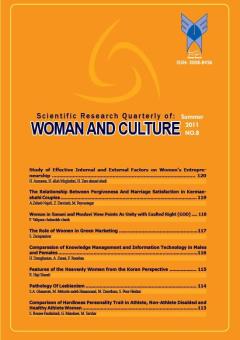Study of Effective Internal and External Factors on Women's Entrepreneurship
Subject Areas : Sociologyهاجر Aramoon 1 , حبیب الله Mirghafori 2 , حبیب Zare Ahmad Abadi 3
1 - Executive Master of Business Administrator, Yazd University
2 - Member of Economic, Management and Accounting Faculty
3 - Member of Economic, Management and Accounting Faculty
Keywords:
Abstract :
In the recent decades women's entrepreneurship issues have been concerned by the official authorities in order to solve the women's unemployment problem. Although in the past; they did not distinguish between the factors affecting men and women entrepreneurship. But with regard to personality and cognitive differences between men and women, the researchers gradually have differed between the factors affecting men and women entrepreneurship. Since the clothing industry of Yazd is one of the oldest industries in which women's ability to have been exhibited, our purpose in this paper was to identify the internal and external factors affecting women's entrepreneurial activities and studying the relationship between them and the influence of these factors. For this purpose the researcher designed a questionnaire with 55 items. The statistical sample included all the women who have been done entrepreneurship in Yazd clothing industry. In order to test research hypothesis, regression analysis was implemented. Results showed that internal factors including individual attributes, recognizable attributes, role pattern, social culture, organizational components had significant direct linear relationship and environmental components including accessibility of resource and environmental dynamism have nonlinear relationship with woman’s entrepreneurship. Notable point was the mediator roles of environmental factors in relationship to other variables.
-احمدپور داریانی، محمود .کارآفرینی :تعاریف، نظریات، الگوها، فصل اولانتشارات شرکت
،26- پردیس 57 ، تابستان) .( 1379 ) صص( 1
-آراستی، زهرا( 1385 ) .، زنان کارآفرین ایرانی؛ساختارهای فرهنگی -اجتماعی موثر در ایجاد کسب
وکارهای زنانه، مجله پژوهش زنان ،دوره 4 ،شماره 1 و 2، صفحات 93 تا. 120
-آراستی، زهرا،( 1381 ) ، طراحی و تبیین الگوی راه اندازی فعالیت کار آفرینانه توسط زنان و دختران
دانشگاهی ایران، ، موجود در سایت
: www.wenet.ir/index.php?option=com_content&task=view&id
-جواهری، فاطمه( 1383 )، موانع کارآفرینی زنان:بررسی تاثیر نابرابری جنسیتی بر کارآفرینی زنان در
ایران،مجله جامعه شناسی ایران،دوره پنجم،شماره. 2
-زارع احمدآبادی، حبیب،( 1387 ) ، " مدل فرایندی چند بعدی کارآفرینی شرکتی )مطالعه موردی :
بنگاههای کوچک و متوسط استان یزد"(، پایان نامه دکتری، دانشگاه علامه طباطبایی.
-گلرد، پروانه .( 1383 ) .طراحی الگوی توسعه کارآفرینی زنان درایران، پایان نامه دکتری، دانشگاه
آزاداسلامی واحد علوم وتحقیقات.
- Aldrich, H.E., Carter, N.M. and Ruef, M. (2002), “With very little help from their friends:
gender and relational composition of nascent entrepreneurs’ startup teams”, in Bygrave, W.D.,
Brush, C.G., Davidsson, P. et al. (Eds), Frontiers of Entrepreneurship Research 2002,
- Antoncic, Bostjan – Hisrich, Robert D. (2001) Intrapreneurship: Construct refinement and
crosscultural validation. Journal of Business Venturing, Vol. 16, No. 5, 495–527.
- Buttner, H. and Moore, D. (1997), “Women’s organizational exodus to entrepreneurship: selfreported
motivations and correlates with success”, Journal of Small Business Management,
Vol. 35 No. 1, pp. 34-47.
- Covin, J &Slevin, D. (1991) A conceptual Model of entrepreneurship as firm behavior. Entrepreneurship
Theory and Practice, Fall: 7-25.
- Fry, F.(1993). Entrepreneurship: A Planning Approach, Englewood Cliffs NJ.
- Gartner, W. (1989), Who is an Entrepreneur? Is The Wrong Question?. Review of
Entrepreneurship Theory And Practice,13(3), pp. 47-64.
- Gattiker, U.E., Larwood, L (1990), "Predictors for career achievement in the corporate
hierarchy", Human Relations, Vol. 43 pp.703-26.
- Hornaday, J.A. and Aboud, J. (1971), “Characteristics of successful entrepreneurs”, in Mancuso,
J. (Ed.), The Entrepreneur’s Handbook, Artech House, Deadham, MA, 1971, pp. 49-61.
- Hornsby, J.S. Kuratko, D.F. and Zahra, S.A. (2002). Middle managers’ perception of the internal
environment for corporate entrepreneurship: assessing a measurement scale. Journal of
Business Venturing, 17:253-273.
- Lavoie, Dina. (1995); Froum sur I entrepreneurhip feminine quebecois, mentreal, Ecoledes
Hautes Etudes Commerciales Montral.
- Lerner M., Brush C.G., Hisrich r. D.( 1997), Israel Women Entrepreneurs: An Examination of
Factors Affecting Performance , Journal of Business Venturing, vol. 12, pp. 315-339
- Lumpkin, G. T., & Dess, G. G. (2001). Linking two dimensions of entrepreneurial orientation to
firm performance: the moderating role of environment and industry life cycle. Journal of
Business Venturing, 17, 429-451.
- Mattis , Mary C., (2004), “Women entrepreneurs: out from under the glass ceiling”,Women in
Management Review Volume 19 · Number 3 ·pp. 154-163.
- McClelland, D.C. (1961), The Achieving Society, Van Nostrand, Princeton, NJ,
- McClelland, D.C. (1987), “Characteristics of successful entrepreneurs”, Journal of Creative
Behavior, Vol. 21, pp. 219-33.
- Naman, J.L., Slevin, D.P. (1993), "Entrepreneurship and the concept of fit: a model and
empirical tests", Strategic Management Journal, Vol. 14 No.2, pp.137-53.
- Orhan, Muriel; Scott, Don, (2001), “Why women enter into entrepreneurship: an explanatory
model” women in Management Review Vol, 16. No: 5, pp: 232-243.
-Rodermund, E. & Vondracek, F. W. (2002). Occupational dreams, choices and aspirations:
adolescents´entrepreneurial prospects and orientations. Journal of Adolescence, 25, 65-78.
- Sandor, Richard L; Skees, Jerry R;( 1999) "Market for Emissions," Trading the Future, Official
Publication of the Futures and Options Association
Zahra, S. & Covin, J. (1995) Contextual Influence on the Corporate ntrepreneurship-Performance
Relationship. Journal of Business Venturing, 10: 43-58
- Zahra, Shaker A; Garvis, dennis m;(2000), “international corporate Zapalska, A.: A Profile of
Woman Entrepreneurs and Enterprises in Poland, Journal of Small Business Management
35(4), 76–82.
- Lee, Jean, (1996), Incentives for women entrepreneurs in Singapore. Women in Management
Review Volume 11, Number 2 , pp. 18–29.
- McClelland and Janine Swail, Jim Bell, Patrick Ibbotson, (2005), “Following the pathway of
female entrepreneurs A six-country investigation”,International Journal of Entrepreneurial
Behaviour & Research, Vol. 11 No. 2, pp. 84-107.


